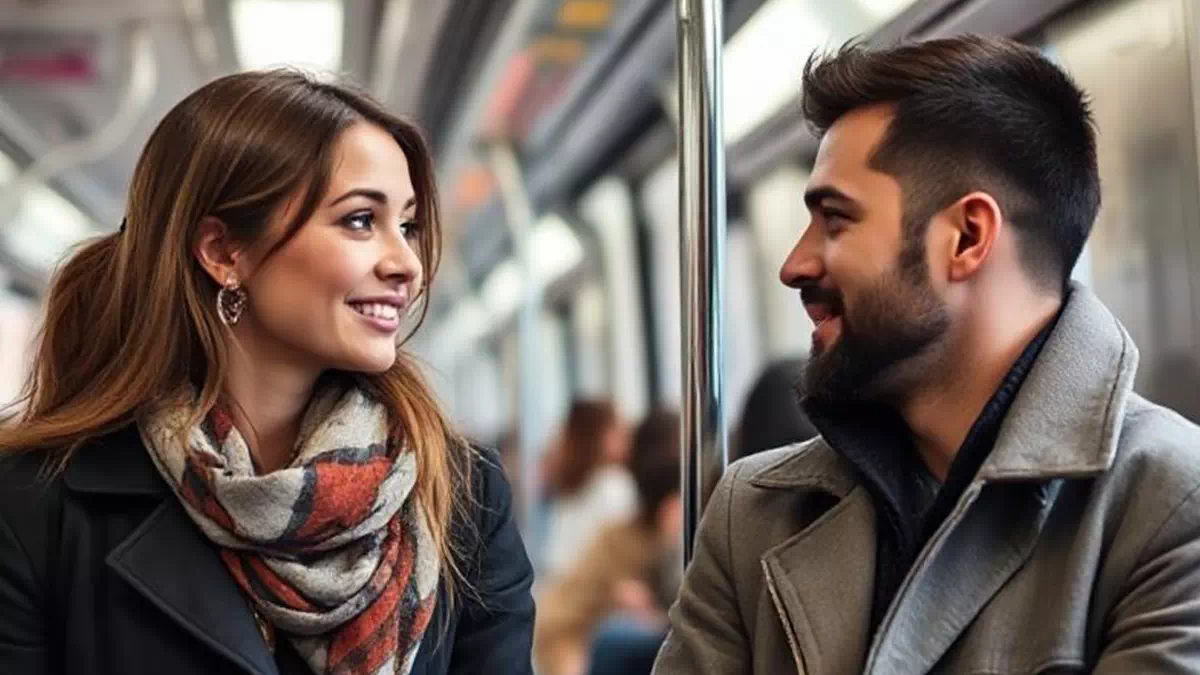Connecting with Men on Public Transport

#2 Conversation Options
Understanding the Public Transport Environment
Public transport serves as a unique social setting where individuals from diverse backgrounds converge. To navigate this environment effectively, consider the following insights:
- Non-Verbal Communication: Your body language is crucial. A friendly smile and an open posture can invite others to engage with you.
- Contextual Icebreakers: Use your surroundings to your advantage. Commenting on the weather, train delays, or even the crowdedness can serve as effective conversation starters.
- Respecting Personal Space: Be mindful of the other person's comfort. If someone appears engrossed in their phone or wearing headphones, it may not be the right moment to approach.
Striking up a conversation with men on trains offers a unique mix of challenges and opportunities. Trains create shared spaces where people are often relaxed, making them ripe for connection during longer or quieter rides. The journey itself—complete with passing scenery and occasional delays—provides natural icebreakers. Unlike the anonymity of street corners or the intensity of one-on-one settings, train cars offer a casual intimacy that can ease interactions. Yet, there are hurdles: many passengers are absorbed in their phones or books, treating this public space as private downtime. Reading body language is key; if he’s wearing headphones or avoiding eye contact, it might not be the right moment to engage. The confined setting also means any unwelcome interaction could lead to awkwardness since you're both stuck in close quarters. Approach lightly—with an offhand comment or a shared smile—to gauge interest without pressure. If he responds warmly by turning toward you or offering more than monosyllabic answers, let the conversation flow naturally from there. Success hinges on sensitivity and respect for personal boundaries; when approached with genuine warmth and awareness, even a simple train ride can spark unexpected connections.

Effective Conversation Starters
Here are some engaging phrases that can help you break the ice without feeling forced:
|
Situation |
Conversation Starter |
|---|---|
|
Waiting for the train |
"Have you heard any updates on the train schedule? It seems like we're in for a wait!" |
|
During a delay |
"Looks like we have some extra time on our hands! What do you think about this weather?" |
|
Seating next to someone |
"Is this seat taken? I promise I’m not a chatterbox!" |
|
Shared commute |
"I see we take the same route often. Any favorite spots you’d recommend nearby?" |
When approaching men on trains, the best conversation starters and ice breakers for women are those that feel casual, situational, and non-intrusive, allowing for a natural exchange without putting too much pressure on either person. Since both of you are sharing a temporary space, it's helpful to start with light, observational comments or simple questions related to the journey or surroundings. For example, you might say, “Is this your usual route?” or “Do you know how long the delay is?”—both openers create a shared context that doesn’t feel forced. Noticing something he's doing can also be a great entry point, like, “That book looks interesting—would you recommend it?” or “Nice watch—do you collect them?” These kinds of comments show genuine interest and invite him to talk about something he enjoys. Humor can also work well in the right moment, such as joking, “So, do you think this train will break the speed record today?” The key is to keep your tone light, friendly, and open, while also paying attention to his body language—if he turns toward you, smiles, or asks something back, you’re on the right track. Effective ice breakers on trains don’t feel like pick-up lines—they feel like little bridges to a simple, human moment.
Building a Connection
Once you've initiated a conversation, the next step is to cultivate a connection. Here are some tips to keep the dialogue engaging:
- Active Listening: Show genuine interest in the other person's responses. Nod, maintain eye contact, and ask follow-up questions to demonstrate your engagement.
- Share Relatable Experiences: Relate to their stories by sharing your own experiences. This creates a sense of camaraderie and encourages them to open up further.
- Be Mindful of Time: Public transport rides can be brief. Gauge the other person's interest and be respectful of their time constraints.

Common Challenges and How to Overcome Them
While initiating conversations can be rewarding, there are challenges that may arise. Here are some common obstacles and strategies to navigate them:
|
Challenge |
Solution |
|---|---|
|
Fear of Rejection |
Remember that not every attempt will lead to a conversation. Approach with a light heart and be prepared to move on if the other person is not interested. |
|
Uncomfortable Situations |
If the conversation turns awkward or the other person seems disinterested, gracefully exit the dialogue by saying something like, "It was nice chatting, have a great day!" |
|
Noise and Distractions |
In a noisy environment, try to position yourself closer to the person you want to talk to, or wait for a quieter moment to initiate the conversation. |
|
Time Constraints |
Be mindful of the other person's schedule. If they seem rushed, keep the conversation brief and to the point. |
How to Learn
Mastering the art of striking up conversations with men on public transport can transform your social interactions. Initially, anxiety and fear of rejection might loom large, but facing these emotions head-on is key to overcoming them. The more you engage in casual chats on buses or trains, the easier it becomes to handle unpredictable responses. Public transport offers a treasure trove of conversation starters—think delays or intriguing outfits—and provides a low-pressure setting for honing this skill. Equipping yourself with conversation openers and strategies from resources like Talk2Any1 can ease the process. Approach each interaction with curiosity rather than expectation; not every dialogue will flourish, but each attempt enriches your understanding of body language and interest levels. Over time, rejection morphs into a learning opportunity that sharpens your instincts instead of diminishing confidence. With practice, you'll watch your anxiety dwindle as authentic engagement becomes second nature.

Pros and Cons of Engaging in Conversations
Before diving into conversations, it's helpful to weigh the benefits and drawbacks. Here’s a quick overview:
|
Pros |
Cons |
|---|---|
|
Builds Social Skills: Engaging with others enhances your communication abilities. |
Potential for Awkwardness: Not every conversation will flow smoothly. |
|
Creates Connections: You may meet interesting people and expand your social circle. |
Time-Consuming: Conversations can take time, which may not always be available during commutes. |
|
Enhances Daily Commute: Transforming a mundane journey into an enjoyable experience. |
Risk of Misinterpretation: Messages can be misunderstood, leading to uncomfortable situations. |
|
Boosts Confidence: Successfully initiating conversations can improve self-esteem. |
Personal Safety Concerns: Always be aware of your surroundings and trust your instincts. |
Top Tips for Successful Conversations
To maximize your chances of having a successful interaction, keep these key points in mind:
- Be Approachable: Flash a friendly smile and keep your arms open to avoid seeming defensive. Embrace an inviting posture when chatting with others—it signals respect and sets the stage for meaningful dialogue. Non-verbal cues speak volumes, so let your gestures and expressions show openness. To bridge gaps between genders, be aware of how your actions shape communication. By consciously adopting welcoming body language, you foster an inclusive space where everyone feels valued. Next time you're in conversation with someone from another gender, approach them with openness and respect to deepen connections and enhance interactions.
- Use Humor: A light-hearted joke can ease tension and make the conversation more enjoyable.
- Stay Informed: Being well-versed in current events transforms ordinary conversations into captivating exchanges. Staying updated not only showcases your awareness but also arms you with intriguing topics that ignite lively discussions. Whether you're engaging with friends, family, or strangers, talking about the latest news and trends keeps dialogue vibrant and meaningful. Embrace this knowledge as a tool to connect deeply with others and enrich every conversation. Next time words falter, let a recent headline fuel the interaction and watch it flourish.
- Practice Empathy: Embrace empathy and genuinely value others' feelings and opinions. Engage in conversations with an open heart, actively listening to diverse perspectives without judgment. This approach not only deepens connections but also builds mutual respect, paving the way for strong relationships and effective communication.
- Follow Up: If the conversation goes well, consider exchanging contact information to continue the dialogue later.

Conclusion
Engaging in conversations with men on public transport can be a fulfilling experience that enhances your daily commute. By understanding the dynamics of public transport, utilizing effective conversation starters, and being mindful of potential challenges, you can create meaningful interactions that enrich your social life. Remember to approach each conversation with an open mind and a positive attitude, and you may find that these small exchanges lead to significant connections.
As you embark on your journey of engaging with others, keep these tips and insights in mind to navigate the world of public transport conversations with confidence and ease.

